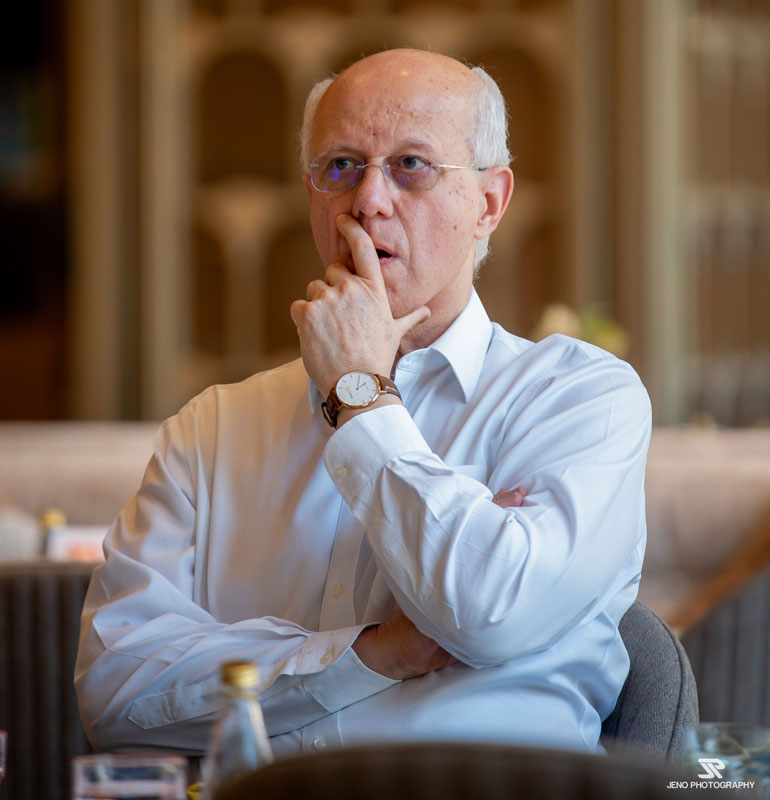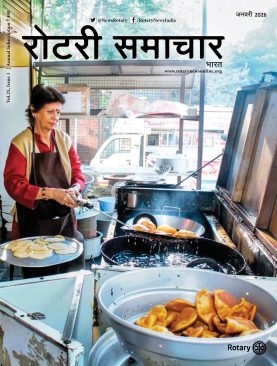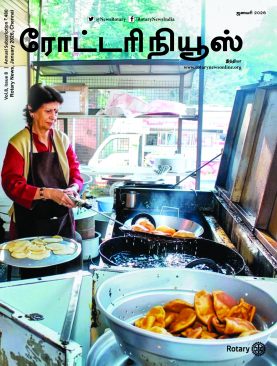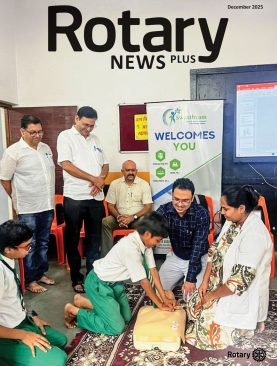
During his recent visit to India, incoming RI President Mario de Camargo took out some time in Madurai to sit down for an interview with Rotary News. As candid as always, he did not mince his words as he expressed serious concern about Rotary’s stagnant, and even falling membership in some countries, and said this was “because we are still male, pale and stale”.
While praising India for membership growth, TRF giving and service projects, he also pointed out that negatives such as bogus clubs and election disputes were spoiling its image, and standing in the way of India holding a convention, because a Rotary convention can only be held in countries “where Rotary is at peace”.
Excerpts from the interview:
How would you sum up the strengths and weaknesses of Rotary in India?
The strengths are clearly membership and giving to The Rotary Foundation. Let me give you the numbers. India, in 2004 had roughly 85,000 Rotarians; today it has 170,000. So, its membership has increased 100 per cent in a period of 20 years. I never take one or two years alone. I always consider the trend… the design of the curve. It’s an ascending curve that India has. In absolute terms, India presents the highest growth in membership in Rotary worldwide the last 20 years. Period…. that’s a fact.
To be divided within Rotary is not the Rotary way. You have to be united in India so that you can claim a Convention for India. True Rotary begins with true clubs, true membership.
Second, years ago, India had a contribution/donation/investment in TRF equalling that of my country, Brazil… roughly about $5 million a year. Brazil is still at $5 million and India reached $32 million (last Rotary year).
Why do you think this is so? Because even Brazil has grown and become an economic powerhouse.
Because India has implemented successfully the CSR (corporate social responsibility) programme. I had the privilege to discuss that with my (late) friend Sushil Gupta when this process was still being discussed and evaluated in the government… Indian Parliament and TRF.
Which year are we talking about?
The year 2016; when I was a (TRF) Trustee, along with Sushil Gupta. So I kind of followed the progress; of course. Sushil followed very closely the evolution of that idea within the political universe in India. And we always exchanged some ideas, because Brazil has a similar law, but which was never implemented with the same efficiency as in India. It is more generous than the India regulation, but it is so limited in terms of the areas of focus that you can invest in, that in practicality very few enterprises take advantage of it.
In India, now you can see an explosion of CSR projects because first, I think here you have a lot more connections between the NGOs and the business world so people are more connected.
Second, the legislation here in India is mandatory, the companies have to invest two per cent of their net profit above a certain level of revenue, in social programmes. In Brazil, it is optional. That makes a big difference. So many companies just let it sit and the money just goes to the government. Because when you do not appoint or assign a specific project to invest that money in, it just rests in the treasury of the national federal government.
On membership growth, are you happy with the growth of women’s numbers in Rotary in India?
I think India is on the right track. It has not reached the level of participation of women in Rotary like the US, where women account for one-third, as also in Brazil, where one in three Rotarians are women.
Are you happy with the kind of projects done by Rotary in India?
Yes, because Indian Rotarians are giving/investing in the Foundation and then using the money in the projects. Oh yes, India is the leader in the utilisation of Rotary funds.
Which is really good for the public image of Rotary because Rotary’s work gets visibility through these projects.
That is exactly why Rotary’s membership in India is growing, because by doing more projects, getting more visibility and hence a better public image, you attract more Rotarians. That is also coupled with the emerging middle class in India. When I visited India for the first time in 2008, it was a different country.
How so?
I saw India as a contrast then between a small minority of very wealthy people and most of the population living in poverty. Today I see a different mood. I see the middle class building, growing. That is one of the reasons for Rotary’s successful growth in India, because of its 400-million strong middle class!
For the last two years two RI Presidents Gordon McInally and Stephanie Urchick, as well as you, have been speaking of concerns in India such as bogus clubs, election complaints, etc. Has this made a difference? Do you see such tough speaking making a difference?
Yes, yes. I said it at the Bangalore institute and I repeated this last night in Mumbai. India is doing very well in terms of membership. You don’t have to resort to fake clubs. That tarnishes the image of the country. Political disputes tarnish the image of the country. For instance, India today would be qualified to hold the convention.
In business you don’t reject customers… but we reject potential Rotarians when we don’t look for new members with intensity. And then we complain that 150,000 Rotarians leave Rotary every year.
According to the latest reports, there is a brand new convention centre in Delhi, capable of holding 20,000–25,000 people, with all the modern facilities. But to be able to hold the convention in India, you have to be a country where Rotary is at peace. We talk about peace and conflict resolution and give scholarships to younger people to educate and enable them to talk about peace in troubled areas. But then we have a country that is divided within Rotary. That is not the Rotary way. You have to be united in India so that you can claim a convention for India. True Rotary begins with true clubs, true membership.
What will be your main priorities as RI President?
Membership, membership.
How will you grow the membership?
We have to rejuvenate our brand in the US, because differently from India where Rotary is still a very attractive proposition, in the US it no longer attracts the younger people. So we will have to build a better image. A rejuvenated image, an image of people in action, purpose, projects.
We are still lagging behind in several areas of the world because we are still male, pale and stale. We have to offer new products, new club formats, new forms of meetings. You don’t have to meet every week, you don’t have to pay for meals, if you want to gather in a happy hour among younger people and develop your projects. That is also a Rotary club.
By ‘pale’ do you mean white men?
Yes.
So what will Rotary have to do differently to get more members?
We have to go back to the lesson we learnt from polio that, alone we can do a lot but if we partner with others, we can change the world. We are pretty good at getting money out of Rotarians’ pockets… Arch Klumph, Major Donors, etc. But we are even better in getting money out of someone else’s pockets… the US, Canadian, Japan or German governments, among others.
So if we are that good in advocating for a cause, why are we not that good in advocating for ourselves? To get more members so that clubs may continue to exist. That’s a reflection; we can plan and make it happen. Just like in business you don’t reject customers… but we reject potential Rotarians when we don’t look for new members with intensity. And then we complain that 150,000 Rotarians leave Rotary every year. Some of that happens due to the natural process, when you have members who are 75, 78, etc. But we have to plan and move forward with commitment, targets, engagement.
The many shades of DEI
When asked if he was happy with the way DEI is working in Rotary, incoming RI President Mario de Camargo had this response:
“DEI has different paces of introduction. I was in Toronto, Canada, last weekend. This is where DEI started, upper northern US and Canada. I told them that the agenda for DEI and the pace of implementation changes according to the region of the world. You cannot force an agenda like DEI at the same speed in all of the Rotary world, as we also have to respect the local culture. DEI in India may be perceived differently from DEI in Canada, Brazil or Germany, and that has to be respected. I told some DEI members of the taskforce in Toronto that you can’t expect the pace of change of DEI in Canada to be the same as in India or the Middle East. You have to respect that Rotary is global and you have to respect the pace of change in different parts of the world when it comes to DEI.”







